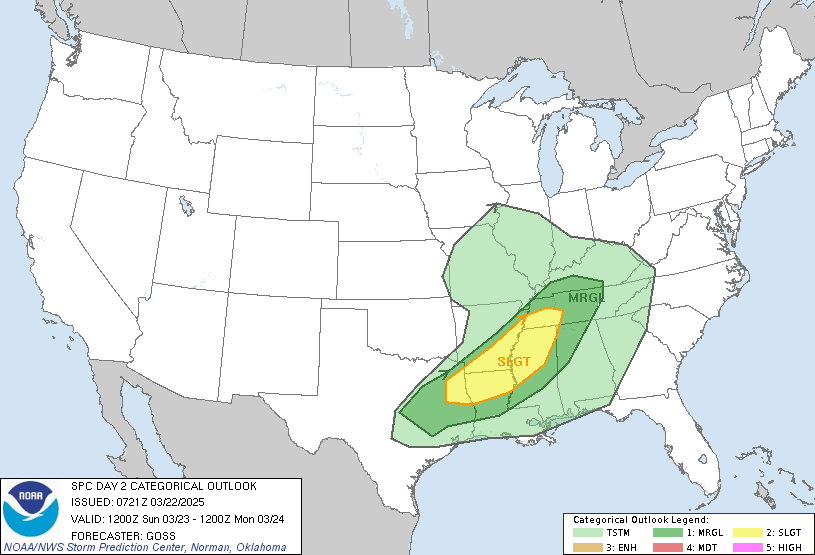LIVE MAP (ABOVE) ... SPC 0600Z Day 2 Outlook
Day 2 Convective Outlook
NWS Storm Prediction Center Norman OK
1203 AM CDT Mon Apr 03 2023
Valid 041200Z - 051200Z
...THERE IS A MODERATE RISK OF SEVERE THUNDERSTORMS LATE TUESDAY
AFTERNOON AND EVENING ACROSS PARTS OF NORTHEASTERN MISSOURI INTO
SOUTHEASTERN IOWA...NORTHWESTERN AND WEST CENTRAL ILLINOIS...
...THERE IS AN ENHANCED RISK OF SEVERE THUNDERSTORMS SURROUNDING THE
MODERATE RISK ACROSS MUCH OF NORTHERN MISSOURI....CENTRAL AND
EASTERN IOWA...NORTHWESTERN AND CENTRAL ILLINOIS...AS WELL AS PARTS
OF NORTHEASTERN TEXAS...SOUTHEASTERN OKLAHOMA...MUCH OF
ARKANSAS...INTO SOUTHERN MISSOURI...
...SUMMARY...
Severe thunderstorms appear likely to develop late Tuesday afternoon
into Tuesday night across the lower Missouri Valley into southern
portions of the Upper Midwest, and across parts of the southeastern
Great Plains into portions of the Mid South. These could pose a
risk for a few strong tornadoes, large hail and damaging wind gusts.
...Synopsis...
As initially amplified mid-level ridging over the mid-latitude
eastern Pacific gradually becomes suppressed, models indicate that
downstream troughing will broaden from the Great Basin into the
Mississippi Valley. This will be lead by a vigorous short wave
trough, which is forecast to be accompanied by continuing strong
surface cyclogenesis from the central Great Plains into the Upper
Midwest, and building downstream mid-level ridging across the Upper
Ohio Valley into Ontario, as well as across the northeastern Gulf of
Mexico into Southeast.
An intensifying southwesterly mid/upper jet streak (including speeds
in excess of 100 kt at 500 mb) nosing across the central Great
Plains through Upper Midwest will contribute to strong deep-layer
shear within the warm sector of the cyclone. At the same time,
intensification of southerly lower-level flow (to 50-70+ kt around
850 mb) likely will contribute to large clockwise-curved low-level
hodographs. This could potentially contribute to an environment
conducive to supercells and organizing lines or clusters capable of
producing strong tornadoes and damaging winds, where large-scale
forcing for ascent and thermodynamic profiles can become favorable.
However, among a number of substantive lingering uncertainties, the
quality of the boundary-layer moisture return from the Gulf of
Mexico remains in question. Due to (at least initially) relatively
shallow boundary-layer depth, downward mixing of drier air might
impact sizable pockets of the potentially broad warm sector through
the day, based on model output. Also, ahead of the mid/upper
troughing, destabilization associated with large-scale ascent and an
influx of high-level moisture from the subtropical Pacific may
contribute to convective development which tends to saturate and
stabilize lapse rates down into the mid-levels, across much of the
Ozark Plateau into middle Mississippi Valley. While it appears that
this will not completely erode the capping elevated mixed-layer air,
thickening cloud cover aloft may inhibit surface heating and
suppress potential thunderstorm development in the absence of lift
to overcome the inhibition.
...Great Plains into the Mississippi Valley...
Both the latest NAM and Rapid Refresh appear increasingly suggestive
that the dryline could surge east-northeastward across southwestern
Iowa and northwestern/west central Missouri, at least above the
surface, by mid to late afternoon, in response to the progression of
at least one speed maximum within the mid-level flow. Model output
generally indicates that largest CAPE will become focused ahead of
this feature, and south of the warm front advancing northward across
central Iowa/northern Illinois during the late afternoon. And the
dryline might provide a focus for sustained discrete supercell
development with the potential to produce strong tornadoes while
propagating northeastward across northeastern Missouri and
southeastern Iowa into northwestern and west central Illinois
through early evening.
In the wake of this activity, as the cold front begins to overtake
the dryline and advance southeastward, various model output
continues to suggest that the evolution of an organizing line or
cluster of storms is possible. This may pose a risk for large hail,
damaging wind gusts, and perhaps a few tornadoes while propagating
east-southeastward across the lower Missouri/middle Mississippi
Valley vicinity into Tuesday night.
Farther south, developments initially along the dryline and then
ahead of the southeastward advancing cold front remain a bit more
unclear. However, there has been a persistent signal within the
model output that a narrow corridor of more substantive
boundary-layer moistening could provide a focus for enhanced severe
weather potential by Tuesday evening. It is possible that
associated destabilization may become aligned with the strong
deep-layer mean flow, possibly allowing for the evolution of one or
two long track supercells, ahead of a developing squall line.
..Kerr.. 04/03/2023
Read more CHECK UPDATE ZOOM GRAPHIC
http://dlvr.it/SlvT9B
Windy.com Temps | Gusts | WU KORD KPWK |
CLICK for this month's BIG night sky ... | RADAR FULL MAP SCREEN |
|---|
MOBILE DEVICE? Turn sideways. Weather conditions directly above are near Lakefront. Top tabs refer to O'Hare (official).
Archives for the SPC Convective Outlook are updated daily (approximately) with a live map at the beginning of each article. Follow the link at the end of the article to check for current updates on the NOAA/NWS Storm Prediction Center website. Also, see Archives for Chicago's hourly weather data on CARDINAL NEWS Magazine.
CONVECTIVE | TORNADO | WIND | HAIL
O'Hare International Airport KORD
(Arlington Heights South)
Chicago Executive Airport KPWK
(Arlington Heights North)
Monday, April 3, 2023
SPC Apr 3, 2023 0600 UTC Day 2 Convective Outlook
SUNRISE AND SUNSET TIMES IN UTC (if you're not logged in to Google)
CHICAGO UTC-6 during CST (Central Standard Time, e.g., winter)
CHICAGO UTC-5 during CDT (Daylight Savings Time, e.g., summer)
CHICAGO UTC-6 during CST (Central Standard Time, e.g., winter)
CHICAGO UTC-5 during CDT (Daylight Savings Time, e.g., summer)





















